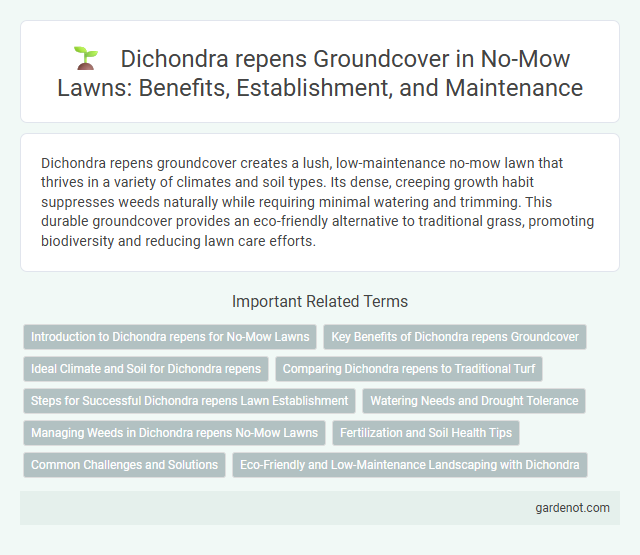Dichondra repens groundcover creates a lush, low-maintenance no-mow lawn that thrives in a variety of climates and soil types. Its dense, creeping growth habit suppresses weeds naturally while requiring minimal watering and trimming. This durable groundcover provides an eco-friendly alternative to traditional grass, promoting biodiversity and reducing lawn care efforts.
Introduction to Dichondra repens for No-Mow Lawns
Dichondra repens is an ideal groundcover for no-mow lawns due to its low-growing, spreading habit that creates a dense, soft green carpet without the need for regular mowing. This perennial plant thrives in full sun to partial shade, tolerates light foot traffic, and requires minimal watering, making it a sustainable and eco-friendly lawn alternative. Its fine, kidney-shaped leaves suppress weeds naturally while enhancing soil health, reducing maintenance effort and environmental impact compared to traditional grass lawns.
Key Benefits of Dichondra repens Groundcover
Dichondra repens groundcover offers excellent drought tolerance and requires minimal maintenance, making it an ideal no-mow lawn alternative. Its dense, low-growing foliage provides exceptional weed suppression and erosion control while maintaining vibrant green color throughout the growing season. This groundcover adapts well to various soil types and shaded areas, enhancing landscape aesthetics with sustainable, eco-friendly performance.
Ideal Climate and Soil for Dichondra repens
Dichondra repens thrives in warm, temperate climates, preferring USDA zones 8 to 11 where mild winters and moderate summer heat prevail. It performs best in well-drained, sandy loam soils with a pH range of 6.0 to 7.5, supporting healthy root development and vibrant foliage. Partial shade to full sun exposure enhances Dichondra repens' growth, making it an excellent choice for no-mow lawn alternatives in suitable environments.
Comparing Dichondra repens to Traditional Turf
Dichondra repens groundcover offers a low-maintenance alternative to traditional turf, requiring significantly less water and mowing frequency. Its dense, creeping growth habit suppresses weeds naturally, reducing the need for chemical herbicides commonly used on conventional lawns. Compared to traditional grass species, Dichondra repens provides superior drought tolerance and a softer texture, making it ideal for eco-friendly landscaping and sustainable lawn care.
Steps for Successful Dichondra repens Lawn Establishment
Prepare a well-draining, fertile soil bed by removing existing grass and debris, then level the area before planting Dichondra repens. Sow seeds evenly at a rate of 1 to 2 pounds per 1,000 square feet, lightly raking them into the soil to ensure good seed-to-soil contact and prevent erosion. Maintain consistent moisture through regular watering, avoid heavy foot traffic during establishment, and mow at a high setting to encourage healthy, dense growth and long-term groundcover success.
Watering Needs and Drought Tolerance
Dichondra repens groundcover thrives with moderate watering, requiring consistent moisture during establishment but benefiting from reduced irrigation once mature. Its drought tolerance is notable, as this low-maintenance plant adapts well to dry conditions by entering a semi-dormant state, minimizing water consumption. Ideal for no-mow lawns, Dichondra repens maintains resilience and aesthetic appeal with minimal supplemental watering in water-restricted environments.
Managing Weeds in Dichondra repens No-Mow Lawns
Dichondra repens groundcover forms a dense, low-growing carpet that naturally suppresses weed growth by limiting light and space for weed seeds to germinate. Effective weed management in Dichondra no-mow lawns includes periodic hand-pulling and the application of selective herbicides that target common broadleaf weeds without damaging the Dichondra. Maintaining proper soil moisture and avoiding over-fertilization helps promote vigorous Dichondra growth, further enhancing its competitive edge against invasive weeds.
Fertilization and Soil Health Tips
Dichondra repens thrives in well-drained, slightly acidic to neutral soils with a pH between 6.0 and 7.0, benefiting from regular fertilization using a balanced, slow-release fertilizer rich in nitrogen, phosphorus, and potassium to promote dense, healthy growth. Incorporating organic matter such as compost enhances soil structure and moisture retention, supporting the plant's resilience and reducing the need for frequent watering. Proper soil aeration and avoiding soil compaction optimize root development, while periodic soil testing ensures nutrient levels remain balanced for optimal groundcover performance.
Common Challenges and Solutions
Dichondra repens groundcover often faces challenges such as slow establishment, susceptibility to drought, and weed invasion. Improving soil drainage, applying mulch to retain moisture, and regular weeding can significantly enhance growth and coverage. Proper watering schedules and selecting drought-tolerant varieties help maintain a healthy, low-maintenance no-mow lawn.
Eco-Friendly and Low-Maintenance Landscaping with Dichondra
Dichondra repens offers an eco-friendly, low-maintenance alternative for no-mow lawns by naturally suppressing weeds and reducing the need for fertilizers and pesticides. This resilient groundcover thrives in various climates, requires minimal watering, and maintains a lush green appearance without regular mowing. Its dense growth improves soil health and supports sustainable landscaping practices, making it ideal for environmentally conscious homeowners.
Dichondra repens groundcover Infographic

 gardenot.com
gardenot.com